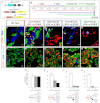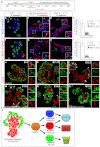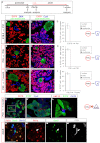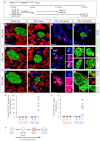Spatiotemporal patterns of multipotentiality in Ptf1a-expressing cells during pancreas organogenesis and injury-induced facultative restoration
- PMID: 23325761
- PMCID: PMC3557774
- DOI: 10.1242/dev.090159
Spatiotemporal patterns of multipotentiality in Ptf1a-expressing cells during pancreas organogenesis and injury-induced facultative restoration
Abstract
Pancreatic multipotent progenitor cells (MPCs) produce acinar, endocrine and duct cells during organogenesis, but their existence and location in the mature organ remain contentious. We used inducible lineage-tracing from the MPC-instructive gene Ptf1a to define systematically in mice the switch of Ptf1a(+) MPCs to unipotent proacinar competence during the secondary transition, their rapid decline during organogenesis, and absence from the mature organ. Between E11.5 and E15.5, we describe tip epithelium heterogeneity, suggesting that putative Ptf1a(+)Sox9(+)Hnf1β(+) MPCs are intermingled with Ptf1a(HI)Sox9(LO) proacinar progenitors. In the adult, pancreatic duct ligation (PDL) caused facultative reactivation of multipotency factors (Sox9 and Hnf1β) in Ptf1a(+) acini, which undergo rapid reprogramming to duct cells and longer-term reprogramming to endocrine cells, including insulin(+) β-cells that are mature by the criteria of producing Pdx1(HI), Nkx6.1(+) and MafA(+). These Ptf1a lineage-derived endocrine/β-cells are likely formed via Ck19(+)/Hnf1β(+)/Sox9(+) ductal and Ngn3(+) endocrine progenitor intermediates. Acinar to endocrine/β-cell transdifferentiation was enhanced by combining PDL with pharmacological elimination of pre-existing β-cells. Thus, we show that acinar cells, without exogenously introduced factors, can regain aspects of embryonic multipotentiality under injury, and convert into mature β-cells.
Figures







References
-
- Ahn S., Joyner A. L. (2004). Dynamic changes in the response of cells to positive hedgehog signaling during mouse limb patterning. Cell 118, 505-516 - PubMed
-
- Baeyens L., De Breuck S., Lardon J., Mfopou J. K., Rooman I., Bouwens L. (2005). In vitro generation of insulin-producing beta cells from adult exocrine pancreatic cells. Diabetologia 48, 49-57 - PubMed
-
- Bertelli E., Bendayan M. (1997). Intermediate endocrine-acinar pancreatic cells in duct ligation conditions. Am. J. Physiol. 273, C1641-C1649 - PubMed
-
- Bouwens L., Rooman I. (2005). Regulation of pancreatic beta-cell mass. Physiol. Rev. 85, 1255-1270 - PubMed
Publication types
MeSH terms
Substances
Grants and funding
- P60 DK020593/DK/NIDDK NIH HHS/United States
- DK58404/DK/NIDDK NIH HHS/United States
- P30 DK058404/DK/NIDDK NIH HHS/United States
- U01 DK089570/DK/NIDDK NIH HHS/United States
- U01 DK072473/DK/NIDDK NIH HHS/United States
- P30 CA068485/CA/NCI NIH HHS/United States
- CA68485/CA/NCI NIH HHS/United States
- DK20593/DK/NIDDK NIH HHS/United States
- U24 DK059637/DK/NIDDK NIH HHS/United States
- U19 DK 042502/DK/NIDDK NIH HHS/United States
- U19 DK042502/DK/NIDDK NIH HHS/United States
- U01 DK 089570/DK/NIDDK NIH HHS/United States
- DK59637/DK/NIDDK NIH HHS/United States
- P30 DK020593/DK/NIDDK NIH HHS/United States
LinkOut - more resources
Full Text Sources
Other Literature Sources
Molecular Biology Databases
Research Materials

